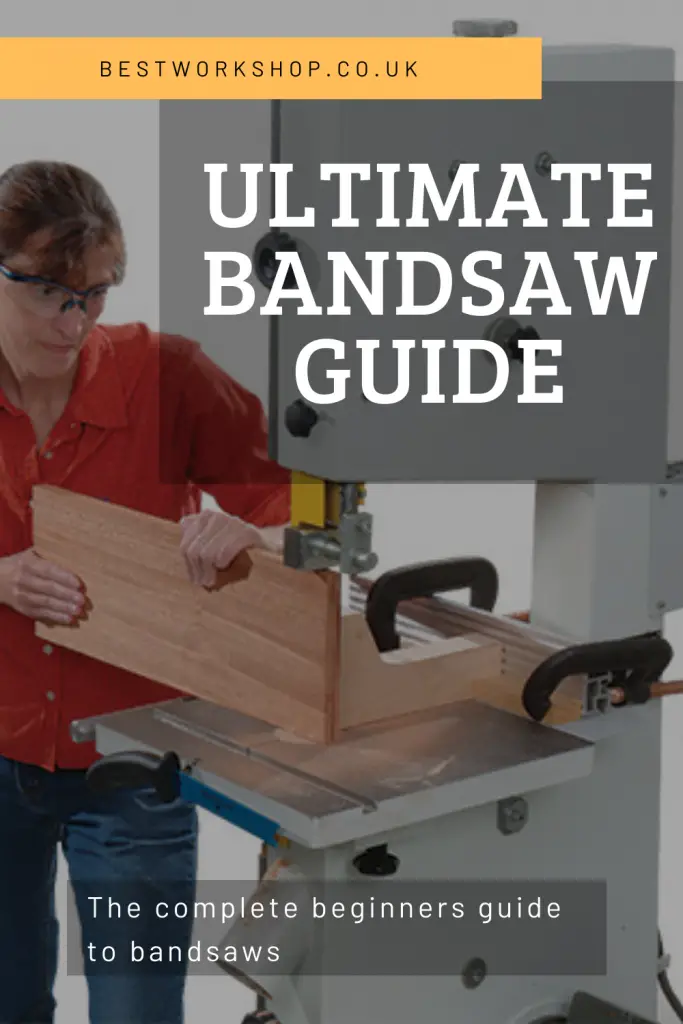Table of Contents
The bandsaw is an invaluable piece of equipment for many woodworkers, tradespeople and DIY enthusiasts and is a versatile tool that can make light work of cutting through various materials.
Whilst it can be fun and often necessary to purchase a bandsaw if you have never used one before, there are some things that you should understand before beginning.
In this ultimate guide, we will provide you with all the information you will need to know about owning and operating a bandsaw.
What Is A Bandsaw?
A bandsaw is a type of cutting tool which makes use of a continuous piece of toothed metal and can be set in either a freestanding cabinet, a tabletop casing or a handheld casing.

Bandsaws are often used to cut wood but are pretty versatile and will make light work of a variety of other materials as well as being easy to use. For this reason, bandsaw DIY is fast becoming one of the most popular hobbies in the country.
What Is A Bandsaw Used For?
When it comes to bandsaw usage, there are many impressive things that they can do. The type of bandsaw you buy will highly depend on how and where you intend to use the tool.
For example, if you have a dedicated workshop with lots of space, you might opt for a freestanding bandsaw. In contrast, if you are working on the go, a portable, or handheld bandsaw might be a better choice.
With this in mind, let’s take a look at the many uses of this diverse piece of equipment.
- Bandsaws are often used to make more complex cuts. Other types of saws are great for cutting straight lines, but a bandsaw has the ability to cut curves, circular lines and other irregular cuts. This is exceptionally advantageous in the woodworking industry and can be invaluable when creating things such as cabriole legs and moulded decorations.
- One of the most common uses is the bandsaw for resawing. This is a process whereby larger pieces of lumber are sawn into thinner pieces. Whether this is done to create veneers or simply to cut wood in half, there is little doubt that this tool is the most adept for the job.
- Rip cuts are one of the most frequently done tasks with a bandsaw. Unlike resawing, which sees the wood cut along the thickness, rip cutting is done along the grain of the wood.
- If you have a lot of pieces of material to cut, then a bandsaw can be an excellent alternative to the hand saw thanks to its electrically-powered design which will limit the physical strain on the user.
The Bandsaw: How To Use
Before you start working with your new tool, it is crucial that you learn how to properly operate it. This is important to get the most precise and neat cut but also for your safety. It goes without saying that anything with a powerful moving blade should be treated with respect.
A bandsaw works on a wheel mechanism which is used to keep the blade rotating. Furthermore, the blade is kept in position with two guides, and this helps to give a better cut. These tools are so effective that they have been in use for more than 200 years, although the models of today are far more advanced than the original.
Using a bandsaw requires minimal effort from the operator thanks to the rotation of the blade – all you need to do is guide the wood as the blade cuts through it. That being said, we have some handy tips that can make your experience a lot easier and with better results.
- When cutting with a bandsaw, you will notice that a rough edge is left behind. For this reason, many experts suggest cutting a little less than you need to give yourself the capacity to smooth the edges.
- If you are going to be cutting a lot of metal, it is imperative that you use the correct blades. Not doing so will give you a lower quality cut and will also cause damage to the blade itself, meaning that it will need to be replaced more frequently. For metal, a blade with hardened teeth is far more preferable than one without. There are many good products on the market, and it is worth sourcing the best bandsaw for metal to ensure the job is done right every time.
- When you are cutting irregular lines or complex patterns, it can be difficult to go the whole way in one fell swoop—making relief cuts along the length of the line will allow waste material to fall away throughout the process. The blade becomes freer, and each cut will feel much more manageable.
- If your blade becomes dull, it is essential to replace it immediately. Not doing so can cause burning, slower speed and difficulty in making those irregular cuts.
Bandsaw Safety
As we mentioned, bandsaws can be incredibly dangerous if they are not used correctly, and it is vital that you observe bandsaw safety at all times during use.
- Never put your hands near the cutting blade. If a piece of stock gets stuck near to the blade, do not be tempted to move it with your hand, instead, use a push stick which is often supplied with the machine.
- Always use the correct safety equipment such as gloves, goggles and ear defenders.
- Before making a cut, be sure to check the bandsaw for any defective parts or irregularities. If the saw is not in 100% working order, do not use it.
- Your material should always remain on the working table – you should never attempt to cut in mid-air.
Types Of Saw
It can quickly become confusing when looking at the right type of saw for your needs, and with so many names flying around, it is little wonder. Let’s take a quick look at the types of saws that cause this confusion.
Bandsaw vs Scrollsaw
The main difference between a bandsaw vs scroll saw is the way in which the blades move. Where a bandsaw’s blade moves in a circular motion, the blade of a scroll saw moves up and down.
Furthermore, the scrollsaw’s blade is much thinner and more rigid than the relatively thick and flexible one you would find on a bandsaw.
For the most part, a bandsaw is used for making larger cuts, whereas a scroll saw will work better at intricate or detailed jobs. Each has their function and are both handy pieces of equipment to have in the workshop.
Bandsaw vs Table Saw
Another common question among woodworkers is how to differentiate between bandsaw vs table saw, and similarly to the scroll saw, there is a clear difference.
Whilst a bandsaw features a continuous blade that runs perpendicular to the work table, a table saw uses a round blade which sticks up from the surface of the work area. A table saw is preferable if you need to adjust the depth of your cut as these can be altered and are usually used to cut straight lines.
Ideas For Bandsaw Uses
Of course, you may already be brimming with ways to use your new saw, and it only takes a quick Google search to reveal thousands of bandsaw projects, but no guide would be complete with a few handy ideas to help you get started.
- Make a bandsaw box.
- Bandsaw taxidermy is a favourite among woodworkers – create a beautiful animal design for a wall hanging or sideboard centrepiece.
- Bandsaw picture frames can be a unique addition to the home and a lovely gift.
- There are many bandsaw projects for kids – under your close supervision, of course.
- Make kitchen equipment such as chopping boards.
- Make bowls for storing your essential items or as a decorative object.
Conclusion
Bandsaws are extremely useful pieces of equipment and are one of the most versatile types of saw that anyone can have in the home or workplace.
This is mainly thanks to their ability to cut through a variety of materials including wood, plastic and metal.
Alongside this, the flexible nature of the blade means that cutting curved or circular lines is incredibly easy.
Before using your bandsaw, it is vital that you follow safety precautions and understand how to use the tool correctly.
This will give you the best results and will prevent injury or the saw from becoming damaged.
There are many ways that you can use a bandsaw; your imagination is your only limit!
If you would like to see my suggestions for the Best Bandsaws to buy, then please see my Buyer’s Guide – The Best Bandsaw UK


